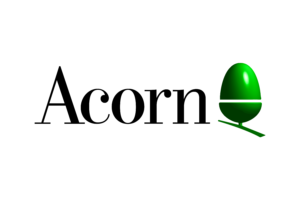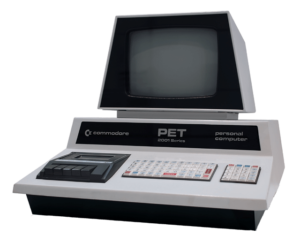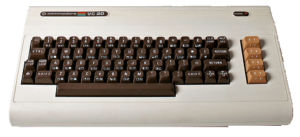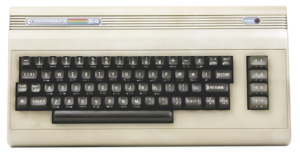Since the 1950’s scientist and engineer have been striving to make electronics, smaller, faster and more affordable. The invention of the transistor lead to many new inventions for the home consumer market. By September 1958, Jack Kilby at Texas Instruments demonstrated the first prototype of the Integrated Circuit (IC) and applied for the patent in February of the following year. Later that year, Robert Noyce (of Fairchild Semiconductor) introduced the first monolithic IC that was far superior to that Kilby’s and became the basis for all modern day ICs used today. The early 1960’s introduced Transistor to Transistor Logic (TTL) and eventually the microprocessor.
Before microprocessors, small computers had been built using racks of circuit boards with many medium- and small-scale integrated circuits, typically of TTL type. Microprocessors combined this into one or a few large-scale ICs. The first commercially available microprocessor, the 4004 was releases in 1971 by Intel. It was a 4 bit processor capable of operating at up to 750 kHz. The Intel 4004 was followed in 1972 by the Intel 8008, the world’s first 8-bit microprocessor.
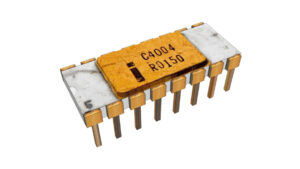
The first 8-bit computers:
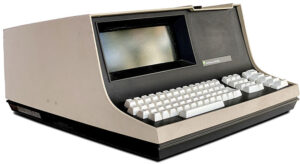
In 1969 the Datapoint 2200 was released by Computer Terminal Corporation (CTC) as a programmable terminal. It’s dual cassettte tape drives allowed it to emulate other terminals by loading the emulation software into memory. Both Intel and Texas Instruments developed prototype microprocessors to help reduce the chip count and in 1972 Intel produced the 8008 processor based on the instruction set developed by CTC’s technical directory Victor Poor years before.
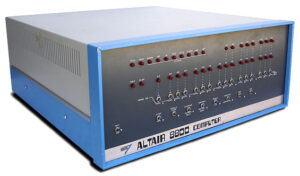
The Altair 8800 was released in 1975 and became the first personal computer. The Altair was sold as a kit and featured the brand new Intel 8080 processor that was release the previous year. The Altair featured no screen or keyboard and would often be paired with a terminal or teletype machine for the user interface. Several months later, the IMSAI 8080 was released (now famous as the personal computers used in the 1983 movie War Games). In 1977, IMSAI bought rights from Gary Kildall to allow the 8800 run CP/M which later evolved into IMDOS. As a result, CP/M became the standard operating system for the Intel based machines and was the foundation for Microsoft DOS.

Nolan Bushnell and Ted Dabney form a new company in June of 1972 and call it Atari. Bushnell hires Al Alcorn to write “Pong” and by November of that year, Atari begins mass production of the new game console which became an unprecedented success. Bushnell would buy out Dadney in 1973 and Atari would produce new games every six weeks by 1974. Al Alcorn created the “Home Pong” console as a consumer product and in 1975 Sears signs a deal to become the exclusive distributor of the console and sell over 150,000 units earning Atari $40 million in sales.
The early processors
1974 & 1975 would see the release of the Intel 8080, the Motorola 6800 and the MOS 6502 processors that would become the leaders in microprocessors for the personal computer market. While Intel became the standard for CP/M based PCs, the Motorola 6800 was selected at the processor for several machines before Motorola licensed right to produce the chip by companies such as NEC and Fairchild. MOS technology release the 6501 processor that was pin compatible with the Motorola 6800, as well as the the 6502 that although similar to the 6501, did not share pin layout with the 6800. The MOS 6502 would become the foundation for some of the most successful personal computers of all times including early Commodore and Apple series computers.
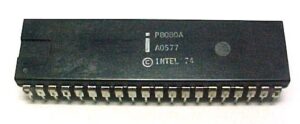
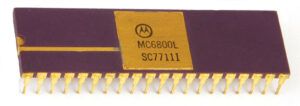
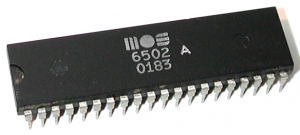
The 1977 Trinity
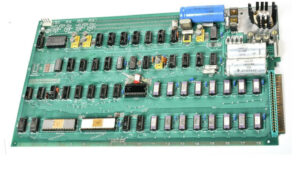
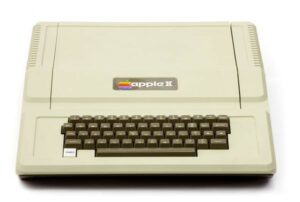
In 1976 two friends, Steve Wozniak and Steve Jobs created their first single board computer under their newly founded company Apple. The Apple computer, (now known as the Apple 1) was débuted at the Homebrew Computer Club that was hosted in Gordon French’s garage. Steve Jobs calculated that if they were able to sell 50 machines at $40.00 each. They were selling the boards only with no electronic components and the board would include a copy of the schematics. Steve Jobs sold his VW van and Steve Wozniak sold his HP calculator to come up with the needed $1000 to fund the creation of the boards. The pair would also convince the Byte Shop to sell 50 fully assembled computers for $500 each with a MSRP of $666.66 as Steve Wozniak likes repeating numbers.
By June of 1977, Steve Wozniak had developed the new circuit board while Steve Jobs developed the classic foam molded case that became the Apple ][ computer. The Apple ][ came with a MOS technology 6502, 4 KB of RAM, a cassette interface video controller and Integer BASIC built-in to the onboard ROMS. The systems was expandable to 48 KB RAM and the video controller could produce 40 x 24 uppercase character on a monochrome screen. Although the Datapoint 2200, the Altair 8800 and IMSAI 8080 were all considered the first personal computers however one could argue that the Apple ][ was the first truly successful modern personal computer.
Six months before the Apple ][ computer was released, Commodore released the PET 2001. The first of several versions of the PET, the 2001 came with a MOS 6502 processor, chiclet style keyboard, an integrated dataset cassette deck, an attached monochrome monitor and either 4 or 8 KB of RAM built into an all-in-one steel case. Commodore was the first company to license Microsoft Basic for the 6502.
After multiple complaints of the calculator style keyboard, Commodore quickly produced the 2001-N (for new) that boasted as standard full size keyboard, support for floppy disk drives but removed the dataset drive and shipped with 8, 16 and 32 KB or RAM options. In 1982, Commodore retired the PET line with the intention of replacing it with the B-series machines; however, they were a marketplace flop and also very expensive to manufacture. Commodore produced the 3000, 4000 and 9000 series of the PET from 1977 until 1982 when the Commodore 64 was released.
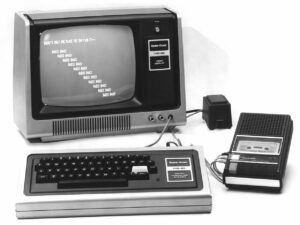
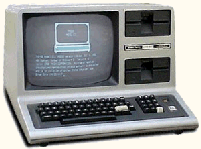
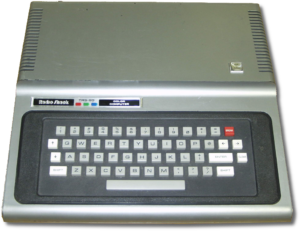
Don French, a Radio Shack employee, bought an Altair 8800 Kit and demonstrated it to the Vice President of manufacturing, John Roach who was unimpressed with the kit but still saw potential in selling a microcomputer. French and Roach would visit National Semiconductor in 1976 where they would meet Homebrew Computer Club member, Steve Leininger. Wanting to hire Leininger as a consultant, National Semiconductor refused to provide Leininger’s contact details however, the pair discovered him working part time at Byte Shop.
Leininger was quickly hired to help work on the new microcomputer project with French and convinced them that producing a pre-assembled computer would sell far more units than a kit. This would make the computer the most expensive product Radio Shack would carry so the company decided to start small and product only 3,500 units initially. If the product was a failure, the stores could use the microcomputers to help keep track of inventory allowing the company to recover from the loss. After showcasing the new computer in 1977, Tandy Corporation (who owned Radio Shack) received over 15,000 order requests for the new machine and over 250,000 joined the waiting list with a $100 deposit.
By 1979, when Radio Shack launched the business-oriented, and incompatible, TRS-80 Model II, the TRS-80 was officially renamed the TRS-80 Model I, in order to distinguish the two product lines. In 1980 the Model III was released and the Model 1 was officially retired with the company siting the new FCC regulations would make it too expensive to continue producing.
The British and European Market
In June 1978, Science of Cambridge launched its MK14 microcomputer in kit form after Ian Williamson showed Chris Curry a prototype based on a National Semiconductor SC/MP microprocessor and parts from a Sinclair calculator. In May 1979, Jim Westwood, Sinclair’s chief engineer, designed a new microcomputer based on the Zilog Z80 microprocessor. Sinclair Instrument Ltd introduced the computer as the ZX80 in February 1980, as both a kit and ready-built.
In 1981, the ZX81 was released as a home computer product and the predecessor to the ZX80. The ZX81 was sold as a fully assembled computer or as a kit for the hobbyist who wanted to save a bit of money. The ZX81 had a base configuration of 1 KB of on-board memory that could officially be expanded externally to 16 KB and ran on the Z80 processor at almost 4 MHz.
In February 1982, Timex Corporation obtained a license to manufacture and market Sinclair’s computers in the USA under the name Timex Sinclair and in April the ZX Spectrum was launched. The ZX Spectrum would become Britain’s best selling microcomputer. The name Spectrum was chosen to highlight it’s color display output compared with the monochrome of the ZX80 and ZX81 models. The ZX Spectrum would see the ZX Spectrum+ and ZX Spectrum 128 before being bought out in 1986 by Amstrad computers who would release several more models over the following year.

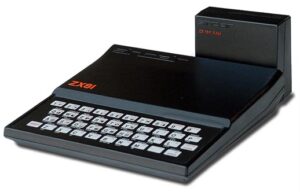
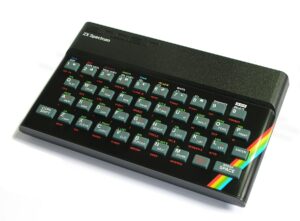
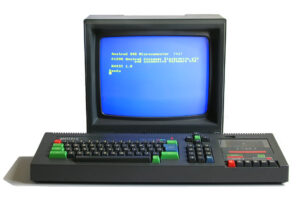
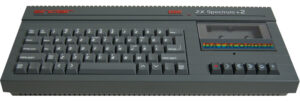
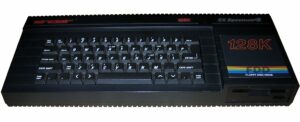
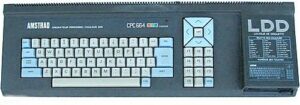
The Amstrad CPC (Colour Personal Computer) is a series of 8-bit home computers produced by between 1984 and 1990. It was designed to compete in the mid-1980s home computer market dominated by the Commodore 64 and the Sinclair ZX Spectrum, where it successfully established itself primarily in the United Kingdom, France, Spain, and the German-speaking parts of Europe.
On 7 April 1986 Amstrad announced it had bought the worldwide rights to sell and manufacture all existing and future Sinclair computers and computer products, together with the Sinclair brand name and those intellectual property rights where they relate to computers and computer related products. This would include ZX Spectrum line and all of Sinclair’s unsold stock. Amstrad launched two new variants of the Spectrum: the ZX Spectrum +2, based on the ZX Spectrum 128, with a built-in cassette tape drive (like the CPC 464) and, the following year, the ZX Spectrum +3, with a built-in floppy disk drive (similar to the CPC 664 and 6128), taking the 3″ disks that many Amstrad machines used. The company would go on to create desktop and laptop and PDA machines before being bought out by British Sky Broadcasting where they continued to make satellite receivers only until finally closing their doors in 2010.
Acorn Computers Ltd. was a British computer company established in Cambridge, England, in 1978 that produced a number of computers which were popular in the UK, including the Acorn Electron and the Acorn Archimedes. Founded by a former employee of Clive Sinclair, Chris Curry and his friend Hermann Hauser formed Cambridge Processor Unit (CPU), after an unsuccessful attempt to convince Sinclair to continuing working on the MK14 project.
In January 1979, CPU released as their first product, a microcomputer kit named the Acorn System 75 under the tradename “Acorn Computer Ltd.” The name Acorn was chosen because the microcomputer system was to be expandable and growth-oriented. It also had the attraction of appearing before “Apple Computer” in a telephone directory. After learning of the development of the ZX80, Curry and another designer, Nick Toop, worked from Curry’s home on the development of the Acorn Atom. It was at this time that Acorn Computers Ltd. was incorporated and Curry moved to Acorn full-time.
In the early 1980’s, the BBC decided to produce an educational program around computer literacy and the microcomputer. Once again Sinclair and Curry would go head to head competing for the rights to produce the official hardware to be endorsed by the broadcasting company. Acorn would win the contract producing the BBC micro in 1981.
In April 1982, Sinclair launched the ZX Spectrum and Curry conceived of the Electron as Acorn’s sub-£200 competitor. It was basically a cut-down BBC Micro, it used an Acorn-designed uncommitted logic array (ULA) to reproduce most of the functionality however, problems in producing the ULAs led to short supply, and the Electron, although launched in August 1983, was not on the market in sufficient numbers to capitalize on the 1983 Christmas sales period.
